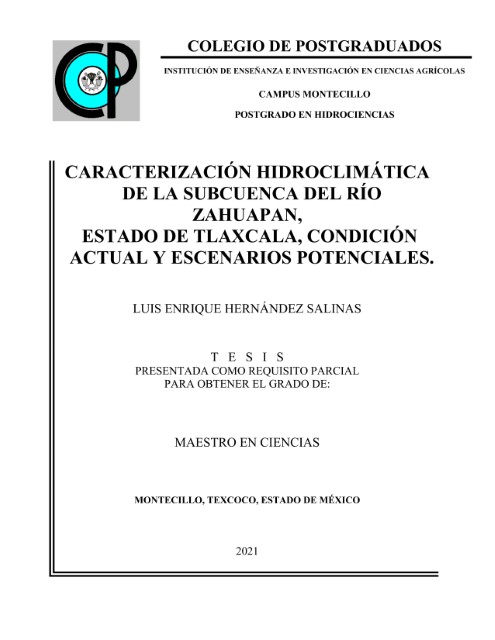
Fecha: 2021-10
LUIS ENRIQUE HERNÁNDEZ SALINAS, M. C. Colegio de Postgraduados, 2021
RESUMEN
La disponibilidad de información sobre los efectos de las
actividades humanas a largo plazo, como lo son los impactos potenciales del
fenómeno de cambio climático sobre los recursos hídricos, es de gran importancia
en la generación de planes y programas de desarrollo territorial, por ello la
presente investigación pretende contribuir a identificar la dinámica hidrológica
general de la subcuenca del río Zahuapan, empleando el método del Balance
Hídrico-Climático de Thornthwaite y Mather para un estado base con promedios
históricos, periodo 1984-2013; y para los escenarios climáticos RCP4.5 y RCP8.5
bajo los Modelos Generales de Circulación de la Atmósfera GFDL-CM3, HADGEM2-ES y
MPI-ESM-LR, hacia los horizontes cercano (2015- 2039) y lejano (2075-2099). El
modelo fue desarrollado en código de programación MATLAB para realizar los
cálculos a partir de archivos TIFF con resolución espacial de 1 ha por celda, y
calibrado mediante comparativa con los escurrimientos mensuales reportados por
la estación hidrométrica 18140-Xicotzingo para el intervalo 1989-1997. Los
resultados del balance hídrico para la subcuenca en el estado base estiman un
volumen total anual de precipitación de 1,193.76, déficit de humedad de 212.54 y
excedentes de 288.19 hm3; bajo los escenarios evaluados se prevén incrementos
promedio del volumen anual de déficit en el horizonte cercano de 42.9 y 33.5 % y
de 76.3 y 116.1 % hacia el horizonte lejano, y reducciones en los excedentes del
26.6 y 22.5 % hacia el horizonte cercano y de 35.6 y 50.4 % en el lejano para
los escenarios RCP4.5 y RCP8.5 respectivamente. Las mayores reducciones en
precipitación e incremento del déficit hídrico se concentran en los valles de
las regiones norte y sur-suroeste, mientras que aumentos en los excedentes de
humedad se manifiestan en las zonas serranas en los extremos norte y oeste de la
subcuenca, y en la superficie del Parque Nacional La Malinche.
Palabras clave: río Zahuapan, cambio climático, Balance Hídrico-Climático,
cuenca hidrográfica, Thornthwaite-Mather, cambio de uso de suelo, Sistemas de
Información Geográfica.
HYDROCLIMATIC CHARACTERIZATION OF THE ZAHUAPAN RIVER SUBBASIN, STATE OF TLAXCALA, CURRENT CONDITION AND POTENTIAL SCENARIOS.
ABSTRACT
The availability of information on the long-term effects of human activities, such as the potential impacts of the climate change phenomenon on water resources, is of great importance in the generation of territorial development plans and programs. This research aims to contribute to identifying the general hydrological dynamics of the Zahuapan river sub-basin, using the Thornthwaite and Mather Water-Climate Balance Method for a base state with historical averages, period 1984-2013; and for the climatic scenarios RCP4.5 and RCP8.5 under the General Atmospheric Circulation Models GFDL-CM3, HADGEM2-ES and MPI-ESM-LR, towards the near (2015-2039) and far (2075-2099) horizons. The model was developed in MATLAB programming code to perform calculations from TIFF files with spatial resolution of 1 ha per cell, and calibrated by comparison with the monthly runoff reported by the hydrometric station 18140Xicotzingo for the 1989-1997 interval. The results of the water balance estimate a total annual volume of precipitation of 1,193.76, a humidity deficit of 212.54 and a surplus of 288.19 hm for the sub-basin in the base state. Under the evaluated scenarios, average of water balance increases in the annual volume of deficit in the near horizon are 42.9 and 33.5% and of 76.3 and 116.1% towards the far horizon, and reductions in surpluses of 26.6 and 22.5% towards the near horizon and of 35.6 and 50.4% in the far horizon for scenarios RCP4.5 and RCP8.5, respectively. The greatest reductions in precipitation and increased water deficit are concentrated in the valleys of the north and south-southwest regions, while increases in excess moisture are manifested in the mountainous areas in the extreme north and west of the sub-basin, and in the La Malinche National Park area.
Keywords: Zahuapan river, Climate change, Water-Climate Balance, Hydrographic basin, Thornthwaite-Mather, Land use change, Geographic Information Systems.